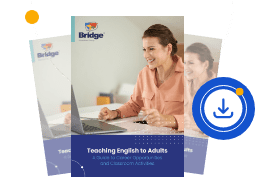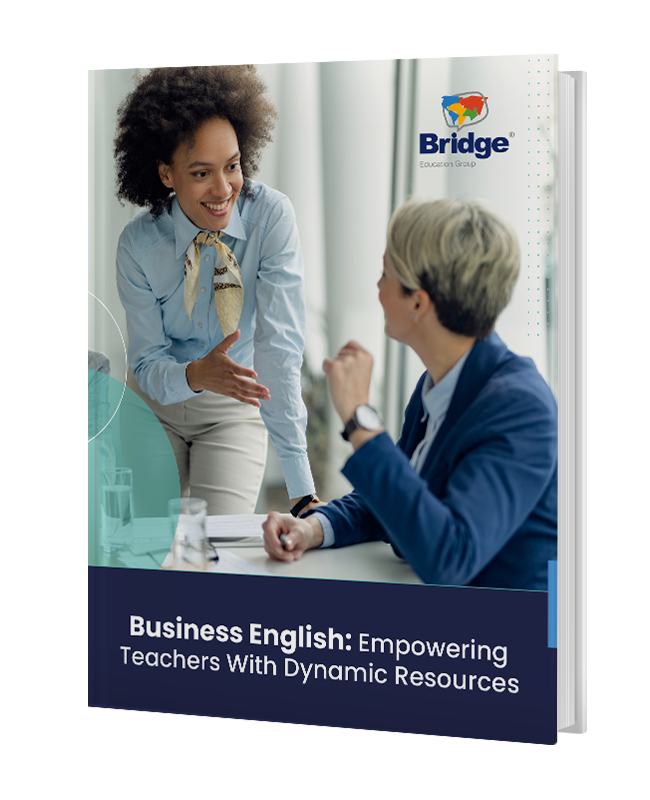From learning corporate terms to mastering expressions for negotiating, Business English is brimming with topics on how students can thrive in the workplace. Teaching each concept, however, requires thorough planning and choosing the most effective materials and methods. Whether you’re new to teaching professionals or are a seasoned Business English teacher looking to design better classes, here are some teaching Business English lesson plans you can use for different types of learners.
What are some tips for teaching Business English lessons?
Before you get started in mapping your Business English classes out, here are some pointers to keep in mind when specializing in this ELT niche:
- Make sure that you know your students’ backgrounds. Where do they work? What are they responsible for? How do they use English at work? Conduct a needs assessment before launching into your course.
- Get your learners comfortable before you start your lessons by using icebreakers, Business English games, and other warm-up activities.
- Provide vocabulary and practice activities that students will be able to use at their actual jobs.
- Prioritize skills that your learners need at work. If they often meet with offshore clients, for example, business meeting phrases should be one of the first lessons you teach.
- Define your lesson objectives and teaching strategies by making use of Bloom’s taxonomy, which classifies cognitive skills.
Consider these additional strategies, from the Bridge Specialized Certification in Teaching Business English course, when planning your overall curriculum, as well as your individual lesson plans:
Business English lessons for beginners
These free Business English lesson plans are great for professional students with a lower level of English. They can be used in both online and in-person classes.
Find out how to get a job teaching Business English.

Lesson plan #1: Types of companies
Lesson topic: Types of companies
Lesson objectives: By the end of the lesson, students will be able to describe different types of companies and say the products or services each one produces or provides.
Materials:
- A physical or virtual whiteboard
- PowerPoint slides containing 10 logos of different companies and pictures of different types of companies
| Steps | Procedures | Time on Task |
|---|---|---|
| 1. Greeting | Teacher (T) and students (S) will greet each other. | 5 minutes |
| 2. Warm-up: Logo game | T will show different logos from different companies, and students will say the name and the nationality of each company. | 10 minutes |
| 3. Topic presentation: Types of companies | T will show a list of vocabulary words and pictures of types of companies (finance, automobile, etc.). S will have to match the words with the pictures and name specific companies for every type of company. | 10 minutes |
| 4. Topic presentation: Verbs for describing companies | T will create three columns on the board (or digital whiteboard). The first column will contain a mix of companies that sell products (cars, clothes, etc.) and those that provide services (telecommunication, flights, etc.). The second column will contain these verbs: produces, makes, provides, and offers. The third column will contain words for products and services such as clothes, cars, internet, etc. S will have to create a variety of sentences by making different combinations of the words in the three columns. T will check if the verbs are correctly used. | 10 minutes |
| 5. Practice | S will think of five companies that they know and write a description of each one using the verbs they learned. | 10 minutes |
| 6. Presentation | T will tell S that they have to talk about their company by describing which type it is and the products or services it offers. | 10 minutes |
Teach business English online and join a team of global educators
Bridge Corporate Language Learning
Apply TodayLesson plan #2: Staying at a hotel
Lesson topic: Staying at a hotel
Lesson objectives: By the end of the lesson, students will be able to make requests and ask for information in a hotel.
Materials:
- A physical or virtual whiteboard
- PowerPoint slides containing a list of expressions for booking a room, checking in, and asking about hotel services
- An audio file or video of a hotel receptionist and guest (like this one)
| Steps | Procedures | Time on Task |
|---|---|---|
| 1. Greeting | Teacher (T) and students (S) will greet each other. | 5 minutes |
| 2. Warm-up: A-Z race (travel) | T shows a list of expressions for booking a hotel room, checking in, and asking about services. | 5 minutes |
| 3. Topic presentation: Listening activity on business travel | T will ask students if they travel for work or if they know anyone who goes on business trips. T can add follow-up questions related to traveling for business and the accommodations students choose. T will then tell S that they will listen to a conversation between a person traveling for work and a hotel receptionist. Before the listening activity, T will pre-teach vocabulary that S will hear in the audio. After listening to the conversation, T will ask what the visitor’s requests were. | 15 minutes |
| 4. Topic presentation: Expressions for staying in a hotel | T will write down some of the expressions used in the audio and elicit whether the visitor or the hotel receptionist says the express. Then, T and S listen to the audio together to check. T shows a list of expressions for booking a hotel room, checking in, and asking about services. | 10 minutes |
| 5. Practice | T divides the students into pairs. Each S in each pair will take on the role of either a visitor or a receptionist in a hotel. Each student pair practices booking a hotel room, checking in, and asking about the hotel’s services. | 10 minutes |
| 6. Presentation: Roleplay | Each pair presents their dialogue to the class. | 10 minutes |
Business English lessons for intermediate learners
The following teaching Business English lesson plans are great for intermediate learners who already have a thorough understanding of basic English concepts.
Lesson plan #3: Modals of obligation, necessity, and prohibition
Lesson topic: Modals of obligation, necessity, and prohibition
Lesson objectives: By the end of the lesson, students will be able to talk about the rules in their workplace using the modals of obligation, necessity, and prohibition.
Materials:
- A physical or virtual whiteboard
- Handouts (or PowerPoint slides) of some of the points from this article on company policies
| Steps | Procedures | Time on Task |
|---|---|---|
| 1. Greeting | Teacher (T) and students (S) will greet each other. | 5 minutes |
| 2. Warm-up | T will elicit various company rules from S and write them on the board. | 10 minutes |
| 3. Topic presentation: Reading | T will tell S that they will read an article on office rules. Before the reading activity, T will pre-teach some of the vocabulary words in the text. | 10 minutes |
| 4. Topic presentation: Modals of obligation, prohibition, and necessity | T will extract some of the sentences in the article that use the modals “must,” “have to,” “can,” and “allowed to,” as well as their negative forms. T will ask students to identify which sentences talk about an obligation, necessity, and prohibition. T will show a chart of the different modals and their uses. | 10 minutes |
| 5. Practice | T will ask S about the most common rules in different establishments, sporting arenas, or event venues. S will have to answer using the modal verbs in the chart. | 10 minutes |
| 6. Presentation | S will give a short speech on the most important rules in their company. S will have to use the modal verbs they’ve learned. | 10 minutes |
Help your Business English students reach their learning goals with the free guide to
Business English: Empowering Teachers With Dynamic Resources
downloadLesson plan #4: Making a request by email
Lesson topic: Making a request by email
Lesson objectives: By the end of the lesson, students will be able to write a formal email to make a request.
Materials:
- A physical or virtual whiteboard
- PowerPoint slides showing expressions for writing formal emails
- An example of a professional email chain
| Steps | Procedures | Time on Task |
|---|---|---|
| 1. Greeting | Teacher (T) and students (S) will greet each other. | 5 minutes |
| 2. Warm-up | T will come up with a list of informal expressions mixed with a list of their formal counterparts. Ex: What’s up (informal) = How are things going? (formal). T will ask students to create pairs of informal and formal expressions that have the same meaning. | 10 minutes |
| 3. Topic presentation: Formal expressions for making requests by email | T will show five short formal emails showing correspondence between a customer and a customer service assistant. T will ask students to arrange the emails in the correct order. Then, S will read the email chain. T will ask students to identify the formal expressions used in the emails. T can also elicit the verbs used to make the emails sound formal (e.g., receive instead of get). | 10 minutes |
| 4. Practice | T will show some informal requests on the board. S will then write the formal versions of the requests. | 10 minutes |
| 5. Presentation | T will provide a problematic situation for the S (i.e., their software doesn’t work). S will have to write a formal email to explain the problem and ask for a solution. | 10 minutes |
In a BridgeUniverse Expert Series webinar, panelists discussed how Business English teachers can tackle the topic of writing business emails with their students. For additional lesson plan ideas, check out what these experts had to say:
Business English lessons for advanced learners
Lastly, these teaching Business English lesson plans should ideally be used with advanced students who are looking to take their language skills to the ultimate level: fluency.
Lesson plan #5: Working with people from different cultures
Lesson topic: Working with people from different cultures
Lesson objectives: By the end of the lesson, students will be able to talk about their experiences working with people from other countries and give advice on cross-cultural work relationships.
Materials:
- A physical or virtual whiteboard
- Handouts (or PowerPoint slides) of the article 10 Ways to Work Effectively Across Cultures
| Steps | Procedures | Time on Task |
|---|---|---|
| 1. Greeting | Teacher (T) and students (S) will greet each other. | 5 minutes |
| 2. Warm-up | T will create two columns on the board, one for “pros” and one for “cons.” T will elicit from S the pros and cons of working with people from other cultures. T will write S answers on the board. | 10 minutes |
| 3. Topic presentation: Article reading | T will pre-teach the vocabulary in the article on working across cultures. S will read the article. T will ask S for the advice that they find the most useful in the article and elicit other tips they can think of. | 10 minutes |
| 4. Topic presentation: Verb + noun collocations | T will extract verb + noun collocations from the article and write them on the board (e.g., relationships instead of build relationships). S will then find the verb pair for each collocation. T will provide the definition for each verb + noun phrase. S will match the phrases with their meanings. | 10 minutes |
| 5. Practice | Using the new collocations, S will write five pieces of advice for people from other cultures who plan to work or do business in their country. | 10 minutes |
| 6. Presentation | S will talk about their experiences working abroad or with people from other countries and the lessons they’ve learned. | 10 minutes |
If you’re struggling to incorporate classroom tasks like those outlined in these free Business English lesson plans, take a look at the following video from the Specialized Certification in Teaching Business English course. It offers tips for conducting task-based learning in a Business English classroom:
Lesson plan #6: Creative presentations
Lesson topic: Creative presentations
Lesson objectives: By the end of the lesson, students will be able to present a product, a service, or an idea creatively.
Materials:
- Five different simple objects (a ball, a bag, etc.)
- Equipment to play a video
| Steps | Procedures | Time on Task |
|---|---|---|
| 1. Greeting | Teacher (T) and students (S) will greet each other. | 5 minutes |
| 2. Warm-up: Pitch challenge | T will show different simple objects and ask S to convince different types of audiences (e.g., a group of children or doctors) to buy the product. The other students can act as the audience members. | 10 minutes |
| 3. Topic presentation: Video | T will introduce the video “How to Start Your Presentation with a Killer Intro” and pre-teach vocabulary. After watching the video, S will have to give a summary of the tips mentioned in the video. T will elicit from S other creative ways to present a product, a service, or an idea. | 10 minutes |
| 4. Practice | T will provide different topics or situations that require a good introduction, such as a motivational speech, a proposal, etc. | 10 minutes |
| 5. Presentation | S will give a presentation on their company’s products or services. | 10 minutes |
Teaching professional students is one of the most rewarding ELT niches to pursue, as these students are highly motivated individuals. With the right teaching Business English lesson plans, you can be sure you’re meeting stakeholder expectations and helping your students succeed.










